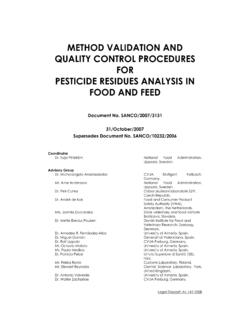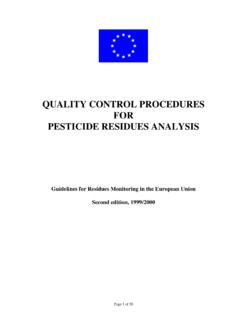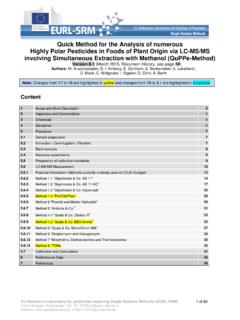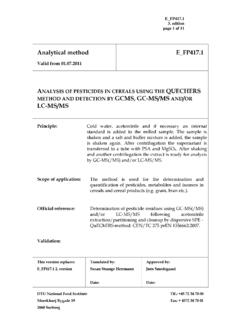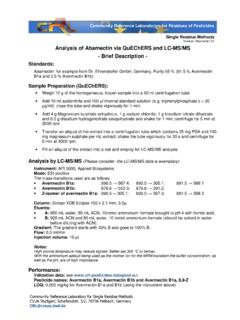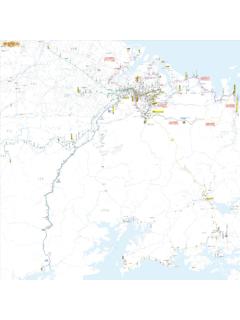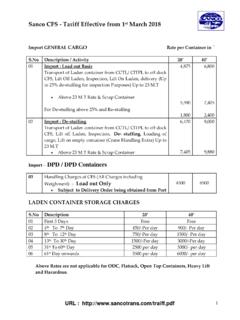Transcription of METHOD VALIDATION AND QUALITY CONTROL …
1 METHOD VALIDATION AND QUALITY CONTROL procedures FOR PESTICIDE residues analysis IN FOOD AND FEED Document No. SANCO/10684/2009 Supersedes Document No. SANCO/3131/2007 Implemented by 01/01/2010 Coordinator Dr. Tuija Pihlstr m National Food Administration, Uppsala, Sweden. Advisory Group Dr. Michelangelo Anastassiades CVUA Stuttgart, Fellbach, Germany. Mr. Arne Andersson National Food Administration, Uppsala, Sweden. Dr. Andr de Kok Food and Consumer Product Safety Authority (VWA), Amsterdam, The Netherlands. Dr. Mette Erecius Poulsen Danish Institute for Food and Veterinary Research, Soeborg, Denmark. Dr. Amadeo R. Fern ndez-Alba University of Almer a, Spain. Dr. Miguel Gam n Generalitat Valenciana, Spain.
2 Dr. Ralf Lippold CVUA Freiburg, Germany. Mr. Octavio Malato University of Almer a, Spain. Ms. Paula Medina University of Almer a, Spain. Dr. Sonja Masselter AGES GmbH, Competence Center for residues of Plant Protection Products, Innsbruck, Austria. Dr. Hans Mol, Senior Chemist RIKILT - Institute of Food Safety, Wageningen, The Netherlands. Mr. Stewart Reynolds Central Science Laboratory, York, United Kingdom. Dr. Antonio Valverde University of Almer a, Spain. Legal Deposit: AL-1133-2009 TABLE OF CONTENTS Introduction .. 3 Accreditation and legal 3 Sampling, transport, processing and storage of samples .. 4 Sampling ..4 Laboratory sample transportation ..4 Sample preparation and processing prior to analysis .
3 4 Pesticide standards, calibration solutions, 5 Identity, purity, and storage of Preparation and storage of stock standards ..5 Preparation, use and storage of working Testing and replacement of Extraction and concentration .. 6 Extraction conditions and Extract concentration and dilution to Contamination and interference .. 7 Analytical calibration, representative analytes, matrix effects and chromatographic integration .. 8 General requirements ..8 Calibration ..8 Representative Matrix effects and matrix-matched calibration ..10 Standard addition ..10 Effects of pesticide mixtures on Calibration for pesticides that are mixtures of isomers ..11 Calibration using derivatives or degradation products ..11 Chromatographic integration.
4 11 Analytical METHOD VALIDATION and performance criteria .. 12 Qualitative screening methods ..12 Initial METHOD Acceptability of analytical METHOD performance-extended METHOD VALIDATION .. 13 On-going performance verification (routine recovery determination) ..13 Methods for determination of fat or dry weight content ..14 Acceptability of analytical performance for routine recoveries .. 14 Proficiency testing and analysis of reference materials .. 15 Confirmation of results .. 15 Identification ..16 Mass spectrometry coupled to Requirements for chromatography ..16 Requirements for mass spectrometry (MS) ..16 Confirmation by an independent laboratory ..18 Reporting of results .. 19 Expression of results ..19 Calculation of Rounding of data.
5 19 Qualifying results with uncertainty Interpretation of results for enforcement purposes ..21 Additional recommended 21 Annex 1.. 22 Selection of representative Appendix A.. 25 Appendix 28 Appendix C.. 30 Glossary ..30 Page 3 of 51 METHOD VALIDATION AND QUALITY CONTROL procedures FOR PESTICIDE residues analysis IN FOOD AND FEED Introduction 1. The guidance in this document is intended for laboratories CONTROL or in the monitoring of pesticide residues in food involved in official and feed in the European Union. The document describes the METHOD VALIDATION and analytical QUALITY CONTROL (AQC) requirements to support the validity of data used for checking compliance with maximum residue limits (MRLs), enforcement actions, or assessment of consumer exposure to pesticides The key objectives are: (ii) to provide a harmonized cost-effective QUALITY assurance system in the EU (iii) to ensure the QUALITY and comparability of analytical results (iv) to ensure that acceptable accuracy is achieved (v) to ensure that false positives or false negatives are not reported (vi) to support compliance with ISO/IEC 17025 (accreditation standard) 2.
6 This document is complementary and integral to the requirements in ISO/IEC 17025. 3. This document supersedes Document No. SANCO/3131/2007. 4. The glossary (Appendix C) should be consulted for explanation of terms used in the text. Accreditation and legal background 5. In accordance with Article 12 of Regulation 882/2004, laboratories designated for official CONTROL of pesticide residues must be accredited to ISO/IEC 17025. According to article 11 of Regulation 882/2004, analysis methods used in the context of official controls shall comply with relevant Community rules or with internationally recognised rules or protocols or, in the absence of the above, with other methods fit for the intended purpose or developed in accordance with scientific protocols.
7 Where the above does not apply, VALIDATION of methods of analysis may further take place within a single laboratory according to an internationally accepted protocol. According to Article 28 of Regulation 396/2005, technical guidelines dealing with the specific VALIDATION criteria and QUALITY CONTROL procedures in relation to methods of analysis for the determination of pesticide residues may be adopted in accordance with the procedure referred to in Article 45(2) of this regulation. The present document entails mutually acceptable scientific rules for official pesticide residue analysis within the EU as agreed by all Member States of the European Union and constitutes a technical guideline in the sense of article 28 of Regulation 396/2005.
8 It should thus be consulted in audits and accreditations of official pesticide residue laboratories according to ISO/IEC 17025. Page 4 of 53 Sampling, transport, processing and storage of samples Sampling 6. Laboratory samples should be taken in accordance with Directive 2002/63/EC or superseding legislation. Where it is impractical to take primary samples randomly within a lot, the METHOD of sampling must be recorded. Laboratory sample transportation 7. Samples must be transported under appropriate conditions to the laboratory in clean containers and robust packaging. Polythene bags, ventilated if appropriate, are acceptable for most samples but low-permeability bags ( nylon film) must be used for samples to be analysed for residues of fumigants.
9 Samples of commodities pre-packed for retail sale should not be removed from their packaging before transport. Very fragile or perishable products ( ripe raspberries) may have to be frozen to avoid spoilage and then transported in dry ice or similar, to avoid thawing in transit. Samples that are frozen at the time of collection must be transported without thawing. Samples that may be damaged by chilling ( bananas) must be protected from both high and low temperatures. 8. Rapid transportation to the laboratory, preferably within one day, is essential for samples of most fresh products. The condition of samples delivered to the laboratory should approximate to that acceptable to a discerning purchaser, otherwise samples should normally be considered unfit for analysis .
10 9. Samples must be identified clearly and indelibly, in a way that prevents inadvertent loss or confusion of labelling. The use of marker pens containing organic solvents should be avoided for labelling bags containing samples to be analysed for fumigant residues , especially if an electron capture detector is to be used. Sample preparation and processing prior to analysis 10. On receipt, each laboratory sample must be allocated a unique reference code by the laboratory. 11. Sample preparation, sample processing and sub-sampling to obtain analytical portions should take place before visible deterioration occurs. This is particularly important when the analytical result is to be used to assess consumer intake.
